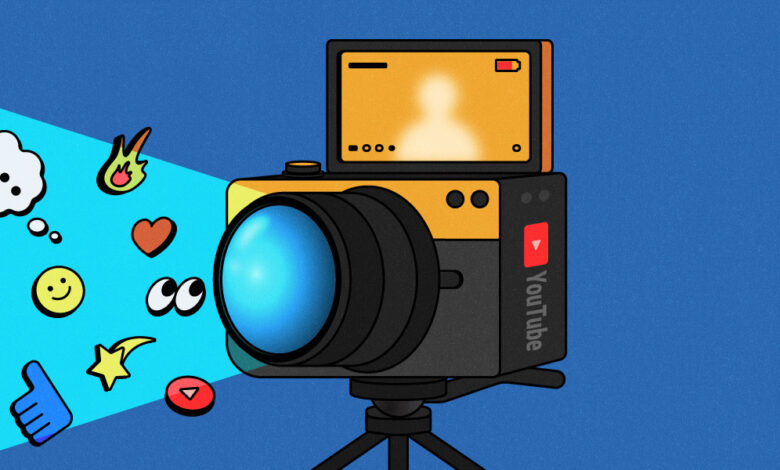Media Briefing: Some podcast execs are not won over by Spotify’s video efforts yet

This Media Briefing covers the latest in media trends for Digiday+ members and is distributed over email every Thursday at 10 a.m. ET. More from the series →
This week’s Media Briefing looks at why podcast organizations and publishers that are doing more video podcast production are primarily focused on YouTube.
Despite Spotify’s investment in developing more video features for podcasts, YouTube still reigns supreme when it comes to where podcast execs are focusing their video efforts, four execs told Digiday.
There are a few reasons why they’re not won over by Spotify’s push into video podcasts yet.
One is simply the growth podcast execs are seeing on YouTube for their video podcasts. Podcast organizations and publishers are still working on upping their video podcast production and figuring out what’s working to attract viewers. For now, execs are seeing subscriber and viewership growth from posting full-length podcast episodes on YouTube, so that is where they are concentrating their efforts.
“It’s exciting [that Spotify is] exploring more video offerings, but not something we’ve interacted with enough to make a determination yet. We’ve been using YouTube for a couple of years now and are simply more established there,” said Eric Sandler, vp of marketing at audiobook and podcast company Pushkin.
Edison Research published in October found that YouTube outranked Spotify for 31% of weekly podcast listeners aged 13 and up, while 27% preferred Spotify. Apple Podcasts came in third with 15%.
Another reason for podcast execs’ focus on YouTube is Spotify’s video podcast efforts are still quite nascent. Execs told Digiday they’re in a wait-and-see mode, before they start taking distribution on that platform more seriously.
“Right now, our videos are not on Spotify but we’re continuing to keep stock of what they’re doing and what they’re rolling out. We’ll keep thinking about whether or not it makes sense to distribute [there],” said Nina Lassam, vp of business and head of audience growth, audio at The New York Times. “I think that we don’t feel a huge rush. And so we’re just seeing how their feature is being used by other publishers, and listening to the market and the user behavior.”
Podcast execs also said the way they distribute podcast videos on other platforms like YouTube isn’t supported in the same way on Spotify.
Colin Tipton, global head of Bloomberg Radio, said they aren’t distributing video podcasts or video of Bloomberg’s live radio show on Spotify right now. And that’s due to Bloomberg’s podcast videos not being a “carbon copy” of the audio podcasts, per Tipton, as well as the unique uploading process to Sportify, which impacts the distribution flow.
“The way we do video [Spotify doesn’t] yet support. Right now on Spotify, you can replace your audio podcast with a video podcast, but you can’t take the audio podcast and leave it there and then add more content. I would love to add our videos… but I don’t want to take away the podcast. That is a technical limit that they have,” Tipton said.
“I don’t want to take away something to add something,” he said.
On YouTube, by comparison, publishers can syndicate an audio-only version of a podcast via its RSS feed, and video podcasts are uploaded as separate pieces of content.
However, that’s not the case for all podcast execs.
Collin Campbell, NPR’s svp of podcasting strategy and franchise development, told Digiday that Spotify is a “huge priority.” NPR has begun producing custom, full-length episodes of the show “Wild Card with Rachel Martin,” with the first episode featuring actor Jesse Eisenberg published on Jan. 30. NPR is also adding short-form video to the show pages.
As Spotify develops more video features on the platform, NPR “will be doing more as we see how the audience responds,” Campbell said.
But whether these efforts on Spotify will lead to viewership growth to NPR’s podcast shows remains to be seen. “It’s honestly too early to say,” Campbell said. “The changes [Spotify is] working on for the platform are happening slowly. We’re going to assess things late this spring as we plan more production.”
For what it’s worth, Spotify’s company earnings on Feb. 4 showed an increase in video podcast interest compared to the previous quarter. The platform said there was an increase of 30,000 podcasts since last November, and that 270 million users have streamed video podcasts, up from 250 million. So the platform is seeing some growth.
In November, Spotify introduced new video offerings aimed at growing its creator monetization programs, including dynamic video podcasts in some countries, short-form podcast clips, and a new creator partner program with video and ad revenue share. Starting last month, creators in the U.S., U.K., Canada and Australia can earn revenue on videos from Spotify Premium subscribers.
“The Spotify Partner Program rewards creators for their video engagement on Spotify while offering Premium listeners an uninterrupted viewing experience — an improvement we see users prefer,” said a Spotify spokesperson. “Although it’s still early, over 70% of eligible creators have already signed up, and their shows are growing faster than audio alone. Tens of millions of podcast fans are watching video podcasts, and more creators than ever are uploading their video content. Clearly, both creators and audiences are embracing the medium — and fewer ads — on Spotify.”
Anecdotally, execs at Wondery, The New York Times, Bloomberg, Vox Media and Pushkin said their podcast audience has grown thanks to their video efforts.
Since spinning out The New York Times podcast channel on YouTube last year, The New York Times has seen a “10x” increase in viewership on the channel, according to Lassam.
Bloomberg Radio’s video podcast channel — since adding video in January 2024 — has grown 600% in subscribers, according to Tipton.
All the execs interviewed for this story said they are producing more video now than they were six months ago, and all had plans to continue that expansion this year, with a focus on full-length episodes on YouTube.
The New York Times hired Brooke Minters in January to oversee video podcast production full time, and she will lead a team of video editors and producers.
“[She is] working with us to figure out how to build the muscle to do this regularly and repeatably,” Lassam said. “Any new [podcast] show will definitely be considered a video audio show… Video will be a feature of all our podcasts.”
Fortune plans to launch two to three more video podcast shows on YouTube by the second half of this year, according to head of video Adam Banicki. It currently has just one show on the platform.
This story was updated to include Spotify’s statement.
What we’ve heard
“Now that we’re in a much more comfortable rhythm of publishing these 30 to 60 minute conversations, why not also make the audio versions of it available?”
— Joe Caporoso, president at Team Whistle, on plans to turn video interview chat shows into audio-only streams on Spotify and Apple Podcasts.
Numbers to know
$20: The amount The Ankler’s annual subscription price will increase, starting this month.
5%: The percentage of Forbes’ staff that will be impacted by a new round of layoffs.
$2.3 million: The amount BDG owes in unpaid rent.
$11. 4 million: The New York Times’ total number of subscribers, after adding 1.1 million net digital-only subscribers in 2024.
What we’ve covered
How Architectural Digest gets YouTube viewers to shop on its site
- After the Condé Nast-owned publication started redirecting viewers of its “Open Door” series from YouTube to its own site to shop the decor, revenue increased four-times, global editorial director Amy Astley said on the Digiday Podcast.
- In March, the publication plans to relaunch the AD Shopping commerce property that it launched in January 2024 and is home to the “Open Door” product showcases as well as shopping selections hand-picked by AD’s own team, including Astley.
Hear more on AD’s changes to its e-commerce strategy this year here.
Publishers are doing more to take control over their programmatic businesses
- Publishers historically have leaned on ad tech vendors to find solutions to the problems associated with programmatic ad businesses, leading to the rise of made-for-advertising sites and the proliferation of bid duplication.
- Some publishers are pushing back, by moving away from outsourcing tools, cutting dependence on Google and bring ad-tech operatinos in-house.
Read more about what publishers are doing to take chare of their programmatic businesses here.
Video viewership on LinkedIn is growing this year
- LinkedIn’s ongoing efforts to woo video creators paid off in the past few months: Short-form video is the fastest-growing content category on LinkedIn, and total video viewership on the platform has increased by 36% year-over-year from Oct. 30, 2024, and Jan. 29, 2025.
- LinkedIn reported 34% year-over-year growth in video uploads in fiscal-Q4 2024 and 36% year-over-year growth in total video viewership in fiscal-Q1 2025.
Read more about video performance on LinkedIn here.
How publishers are choosing LLMs
- Publishers that want to experiment with using generative AI technology need to find large language models to build products and features.
- one of the biggest factors in these evaluations is how easy it is to integrate an LLM into their companies’ tech systems — such as different product suites and content management platforms — according to conversations with three publishing execs. That often means choosing the LLMs owned by companies with which they already have enterprise technology or content licensing agreements.
Read more about what goes into choosing which models to work with here.
What we’re reading
BuzzFeed wants to build its own social media platform
BuzzFeed is considering creating its own social media platform, according to Semafor. CEO Jonah Peretti said this move would be a way to compete with tech companies and have more control over its own content distribution.
Los Angeles Times offers buyouts
The Los Angeles Times is offering voluntary buyouts to employees who have worked for the company for two years or more, the New York Post reported. LA Times owner Dr. Patrick Soon-Shiong cited a “difficult financial situation” that “requires us to remain diligent in managing costs” in an email to staffers.
New York Magazine plans to launch 15 newsletters this year
Vox Media’s New York Magazine wants to produce 15 subscriber-only pop up newsletters this year, up from nine last year, Business Insider reported. The company sees these products as a way to retain subscribers and diversify revenue streams.
Bloomberg says it’s still committed to DEI
Bloomberg News editor-in-chief John Micklethwait sent a memo to staff to reiterate the company’s commitment to DEI initiatives, according to Talking Biz News. This comes at a time when organizations across the U.S. are facing backlash for their diversity programs.
How Joanna Coles and Ben Sherwood turned around the Daily Beast
Joanna Coles and Ben Sherwood made the Daily Beast a profitable business by cutting costs and leaning into aggregation and opinion columns, and a focus on increasing traffic, according to Business Insider.


